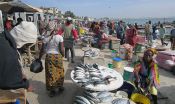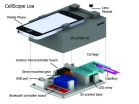(Press-News.org) Scientists at the National Institutes of Health have solved a long-standing mystery about the origin of one of the cell types that make up the ovary. The team also discovered how ovarian cells share information during development of an ovarian follicle, which holds the maturing egg. Researchers believe this new information on basic ovarian biology will help them better understand the cause of ovarian disorders, such as premature ovarian failure and polycystic ovarian syndrome, conditions that both result in hormone imbalances and infertility in women.
Researchers at the National Institute of Environmental Health Sciences (NIEHS), part of NIH, published the findings online April 28 in the journal Nature Communications. According to NIEHS researcher and corresponding author Humphrey Yao, Ph.D., the ovarian follicle is the basic functional unit of the ovary, which contains the egg surrounded by two distinct cell types, known as granulosa cells and theca cells. Yao said scientists had known the cellular origins of the egg and granulosa cells, but did not know where theca cells came from or what directed their development.
"The answer to this question remained unanswered for decades, but using a technique called lineage tracing, we determined that theca cells in mice come from both inside and outside the ovary, from embryonic tissue called mesenchyme," Yao said. "We don't know why theca cells have two sources, but it tells us something important -- a single cell type may actually be made up of different groups of cells."
Without theca cells, women are unable to produce the hormones that sustain follicle growth, he continued. One of the major hormones theca cells produce is androgen, which is widely thought of as a male hormone. But, in a superb example of teamwork, the granulosa cells convert the androgen to estrogen.
As a result of their work, Yao and his colleagues uncovered the molecular signaling system that enables theca cells to make androgen. This communication pathway is derived from granulosa cells and another structure in the ovary called the oocyte, or immature egg cell. The crosstalk between the egg, granulosa cells, and theca cells was an unexpected finding, but one that may provide insight into how ovarian disorders arise.
"The problem starts within the theca cell compartment," said Chang Liu, Ph.D., a visiting fellow in Yao's group and first author on the paper. "Now that we know what makes these cells grow, we can search for possible genetic mutations or environmental factors that affect the process leading to ovarian cell disorders."
For future work, Yao wants to explore the two types of cells that make up theca cells. Since the research has been carried out in mice, Yao will have to determine if the same holds true for humans, but the research may potentially uncover several roles theca cells play in female fertility.
INFORMATION:
NIEHS supports research to understand the effects of the environment on human health and is part of NIH. For more information on environmental health topics, visit http://www.niehs.nih.gov. Subscribe to one or more of the NIEHS news lists to stay current on NIEHS news, press releases, grant opportunities, training, events, and publications.
About the National Institutes of Health (NIH): NIH, the nation's medical research agency, includes 27 Institutes and Centers and is a component of the U.S. Department of Health and Human Services. NIH is the primary federal agency conducting and supporting basic, clinical, and translational medical research, and is investigating the causes, treatments, and cures for both common and rare diseases. For more information about NIH and its programs, visit http://www.nih.gov.
NIEHS CONTACT:
Robin Arnette
(919) 541-5143
arnetter@niehs.nih.gov
Reference: Liu C, Peng J, Matzuk MM, Yao HH-C. 2015. Lineage specification of ovarian theca cells requires multicellular interactions via oocyte and granulosa cells. Nat Commun; doi:10.1038/ncomms7934 [Online 28 April 2015].
Grant number:
ZIAES102965
The Alaska salmon fishery is touted as one of the best in the world. When measured with an ecological yardstick, it is - fish stocks are healthy and the fishery is certified by the Marine Stewardship Council as consistently meeting rigorous biological standards. Fish are individually counted as they swim upstream to ensure there are enough to breed.
But Alaska salmon falls short and lags behind some of the world's fisheries in how it benefits local fishermen, processing workers and nearby rural communities, according to a new assessment that ranks the vitality of a fishery ...
Diets of snakes from a temperate region in South America may depend more on phylogeny (ancestry) than ecology, according to a study published May 6, 2015 in the open-access journal PLOS ONE by Gisela Bellini from Instituto Nacional de Limnología, Argentina and colleagues.
Some scientists believe that the deep history hypothesis based on phylogeny -- the history of evolution, or ancestry and relationships between snakes -- and ecological interactions from the competition-predation hypothesis may act together to determine the structure of snake communities. The authors ...
Post-surgical leaks that develop after a segment of the colon has been removed and stitched back together often are caused not by negligence or technical error but by bacteria in the bowel that elude antibiotics, according to new evidence about this devastating complication of gastrointestinal surgery.
Such leaks, which can develop days or weeks after the procedure, allow the bowel's contents to spill into the abdomen and can cause pain, fever, sepsis and even death.
In patients undergoing high risk surgery such as in the rectum, leak rates can approach 30 percent. ...
Berkeley -- A research team led by engineers at the University of California, Berkeley, has developed a new mobile phone microscope that uses video to automatically detect and quantify infection by parasitic worms in a drop of blood. This next generation of UC Berkeley's CellScope technology could help revive efforts to eradicate debilitating diseases in Africa by providing critical information for health providers in the field.
"We previously showed that mobile phones can be used for microscopy, but this is the first device that combines the imaging technology with ...
The rise of antibiotic-resistant bacteria is a growing problem in the United States and the world. New findings by researchers in evolutionary biology and mathematics could help doctors better address the problem in a clinical setting.
Biologist Miriam Barlow of the University of California, Merced, and mathematician Kristina Crona of American University tested and found a way to return bacteria to a pre-resistant state. In research published in the open-access journal PLOS ONE, they show how to rewind the evolution of bacteria and verify treatment options for a family ...
Scientists from the National Institute of Allergy and Infectious Diseases (NIAID), part of the National Institutes of Health, and the University of California, Berkeley, and colleagues have developed a mobile phone microscope to measure blood levels of the parasitic filarial worm Loa loa. The point-of-care device may enable safe resumption of mass drug administration campaigns to eradicate the parasitic diseases onchocerciasis (river blindness) and lymphatic filariasis (elephantiasis).
Efforts to eliminate these diseases in Central Africa through community-wide administration ...
Just witnessing aggression or other bad behaviour at work can affect our well-being, but the right support from employers and colleagues can limit the consequences.
That is the conclusion of research being presented today, Thursday 7 May 2015, by Dr Christine Sprigg from the Institute of Work Psychology at the Sheffield University Management School at the Annual Conference of the British Psychological Society in Liverpool.
Dr Sprigg and her colleagues surveyed 127 British employees who had witnessed aggression at work. Employees were asked to complete a number of psychological ...
Psychologists are to improve online health information on lung cancer after research showed that family members are more likely to search online to encourage loved ones to seek help.
This is one of the outcomes from research by PhD student Julia Mueller based in the School of Nursing, Midwifery and Social Work at The University of Manchester (part of the Manchester Cancer Research Centre) who will present her study today, Thursday 7 May 2015, at the Annual Conference of the British Psychology Society being held in Liverpool.
Julia Mueller said: "People displaying ...
Children are more likely to display troublesome behaviour in families in which the father feels unsupported by his partner.
The findings by Doctoral Researcher Rachel Latham from the University of Sussex will be presented today, Thursday 7 May 2015, at the Annual Conference of the British Psychology Society being held in Liverpool.
The ways in which parents work together in their roles has been shown to be an important factor in relation to the behaviour of their children. However, few studies have distinguished between mothers' and fathers' perceptions of the support ...
How to protect your chicks from predators? Build a dome over them! There is tremendous diversity among the nests of birds, in nest location, structure, materials, and more, but we know very little about the forces that shaped the evolution of this incredible variety. In a new paper published this week in The Auk: Ornithological Advances, Zachary Hall, Sally Street, Sam Auty, and Susan Healy of the University of St. Andrews in Scotland test the hypothesis that domed-shaped nests arose as a result of some species transitioning to nesting on the ground, where the risk from ...


